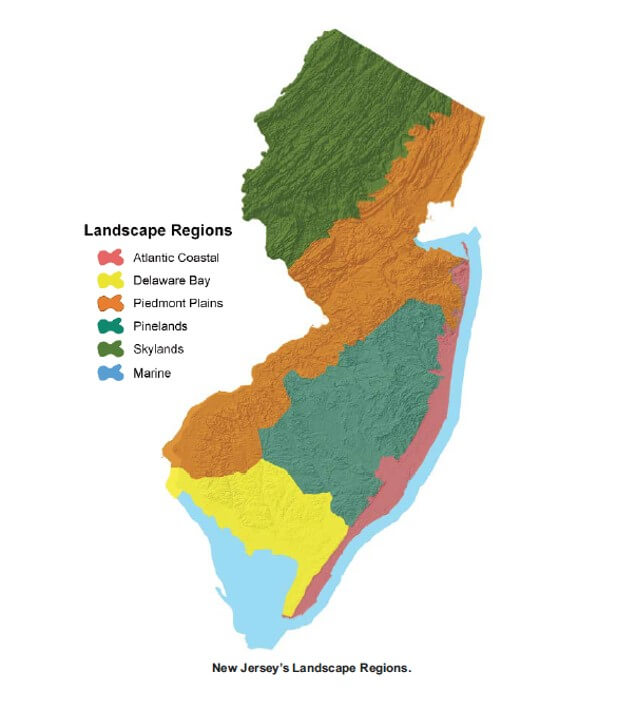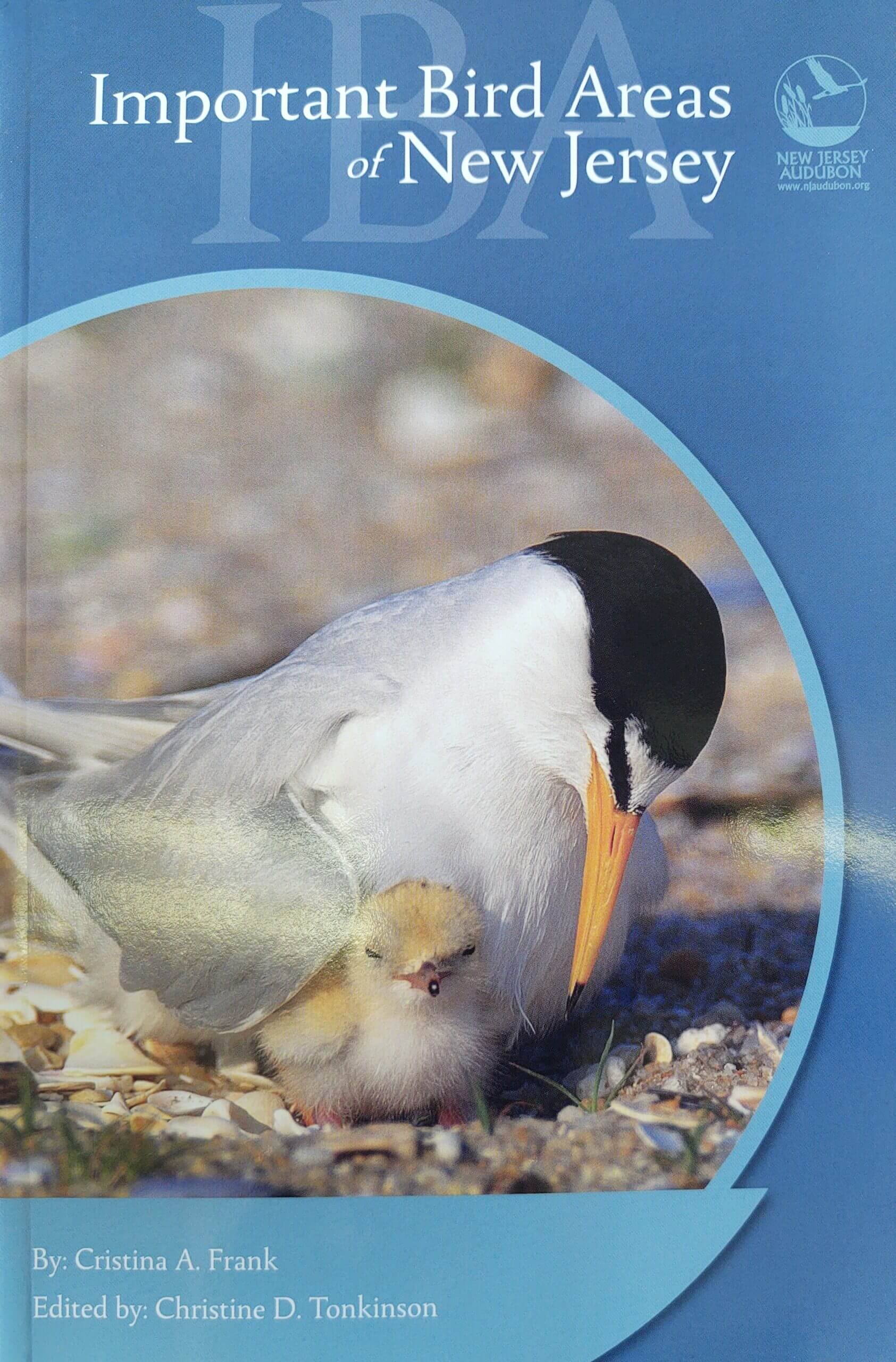New Jersey contains 5 physiographic provinces combined and split into 6 Landscape Regions:
- The Atlantic Coastal Landscape Region encompasses parts of Monmouth, Ocean, Cape May, and Atlantic counties. The beaches and marshes here are among the most productive coastal habitats in the country. Despite heavy development, they support important portions of Atlantic Coast populations of colonial nesting birds, such as common tern, little blue heron and great egret, and endangered beach-nesting birds such as least tern and piping plover. The coastal habitats also support most of the state’s ospreys, northern harriers, and northern diamondback terrapins, as well as large concentrations of migrating birds and wintering waterfowl.
- The Delaware Bay Landscape Region encompasses all or parts of Cape May, Atlantic and Cumberland counties. It features significant populations of bald eagle, barred owl, eastern tiger salamander, Cope’s gray treefrog and 30 other endangered and threatened species. The vast woodland tracts of this region are among the largest in the state and support a large portion of New Jersey’s neotropical birds and interior-forest bird populations. The extensive saltwater marsh and sandy beaches support a significant horseshoe crab spawning area and shorebird migrations of worldwide ecological significance, including that of the red knot. Despite significant losses of habitat, the Cape May Peninsula remains one of the country’s most important migratory “stopovers” for hundreds of bird and insect species. The expansive habitat mosaic of rivers and streams flowing into the tidal Delaware Bay supports concentrations of rare wildlife and wintering waterfowl.
- The Piedmont Plains Landscape Region combines two of New Jersey’s physiographic regions, the Piedmont and the Inner Coastal Plain. It encompasses all or parts of Burlington, Camden, Gloucester, Salem, Mercer, Middlesex, Monmouth, Hunterdon, Somerset, Union, Essex, Hudson, Passaic, and Bergen counties. It is dominated by the Delaware and Raritan rivers and is characterized by farmed areas, extensive grasslands, fragmented woodlands, and productive tidal marshes. Imperiled species within this landscape include grassland birds such as the endangered upland sandpiper, and raptors such as the American kestrel and barred owl.
- The Pinelands Landscape Region encompasses all or parts of Atlantic, Ocean, Burlington, Camden, and Gloucester counties. An internationally recognized ecosystem, the Pinelands supports extremely diverse reptile, amphibian and invertebrate populations including northern pine snake, corn snake, Pine Barrens treefrog, and Pine Barrens bluet. Extensive cedar swamps and wetland systems contain numerous insect species, as well as sustainable populations of many neotropical birds. Its waterways support aquatic communities unique among the Mid-Atlantic states.
- The Skylands Landscape Region combines two of New Jersey’s physiographic regions, the Ridge and Valley and the Highlands. It encompasses all or parts of Sussex, Warren, Hunterdon, Somerset, Passaic, Essex, Bergen, and Morris counties. The region contains extensive tracts of contiguous upland and wetland forests that support diverse animal populations including red-shouldered hawk, northern goshawk, golden-winged warbler, cerulean warbler, timber rattlesnake, long-tailed salamander, arogos skipper, and the state’s only known wintering populations of Indiana bat. Bog turtles and great blue herons inhabit the extensive freshwater wetland systems found throughout the region.
- The Marine Region is an exclusively aquatic region that includes the New Jersey portion of the Delaware and Raritan bays. It also includes the portion of the Atlantic Ocean within New Jersey’s jurisdiction, which is defined as the area within 3-nautical miles of the New Jersey shoreline. This region supports commercially valuable shellfish resources as well as a number of fishes of commercial and recreational importance. Over half of New Jersey’s federally-listed species are found exclusively within this region, including several species of whales and sea turtles. The endangered shortnose sturgeon is also found within Delaware Bay. Waters of the Delaware Bay are also critical habitat to one of the largest populations of horseshoe crab in the world. During the summer, near-shore Atlantic Ocean waters are calving and nursery grounds for bottlenose dolphins, while many additional species utilize these waters as a migratory corridor.

Click here (pdf, 335kb) for a list of wildlife species of greatest conservation need in New Jersey and the regions and habitats they can be found.
Click here for an online field guide for specific wildlife species.
New Jersey Wildlife Viewing Guide
The New Jersey Wildlife Viewing Guide, published in 2009, is available for purchase from online vendors. The Guide leads readers on an exploration of eight New Jersey’s distinct wildlife-watching landscapes and 104 of the state’s best places to see wildlife, diverse habitats, and unique flora and fauna. Beautiful, full-color photographs proclaim New Jersey’s natural grandeur and provide snapshots of what awaits visitors at each viewing site. A three-tiered rating system alerts readers to those must-see locations throughout the state. Other features include driving directions, amenities, trail information, contact information and web addresses. A special section discusses tips and techniques to increase the likelihood of seeing wildlife.

Important Bird Areas of New Jersey

The Important Bird Areas of New Jersey, published in 2010, may be available for purchase as a book from online vendors, but the information on each area is available to the public online. There are 123 different areas identified that provide essential habitat for one or more species of birds and make a contribution to the long-term viability of native avian populations in New Jersey.
Wildlife Management Areas
New Jersey’s Wildlife Management Area System, administered by New Jersey Fish and Wildlife’s Bureau of Land Management, preserves a diversity of fish and wildlife habitats from Delaware Bay coastal marshes to Kittatinny Ridge mountain tops. Ranging in size from the 0.68 acre Delaware River Fishing Access Site at the Pennsauken WMA to the 33,000-acre Peaslee Tract in Cumberland and Cape May counties, Wildlife Management Areas provide countless outdoor recreational opportunities for New Jersey residents and visitors from out of state. Helping make these areas accessible are approximately 1,100 miles of roads (19 paved and 1,081 unpaved).
 Official Site of The State of New Jersey
Official Site of The State of New Jersey
